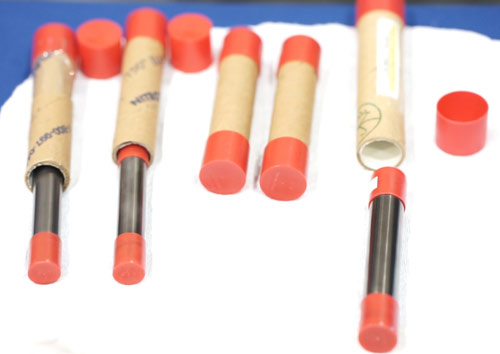
A sample of NitroSteel rods shown at the Fluid Power Technology Conference.
Hydraulic cylinders have a well-deserved reputation for ruggedness and durability. But if a cylinder rod corrodes, it will quickly fail no matter how well it is designed and built. Discussing the subject at last week’s Fluid Power Technology Conference in Milwaukee, hosted by Fluid Power World, experts from Gerdau Special Steel North America, Pleasant Prairie, Wis., explained how the company’s NitroSteel rods give better corrosion protection, compared to chrome-plated cylinder rods. The rods also improve wear and dent resistance, and lubrication retention, and are manufactured using an environmentally “friendly” process, according to the company.
The NitroSteel manufacturing process starts with Gerdau’s high-quality specialty steel bars, made from alloys such as 10V45 and 40V45 typically used in the fluid-power industry, explained Adam Tabor, bar processing superintendent at Gerdau’s Jackson, Mich. Plant. The bars are ground, polished, cleaned and mounted on a fixture, and then lowered into an electrically heated pit furnace 24 ft deep and 6 ft in diameter.
Furnace treatment entails a conventional gaseous nitro-carburizing method using an ammonia and carrier-gas atmosphere. However, they also add a pre-cooling oxidation sequence. Following the heat cycle, treated rods are furnace cooled or quenched.
The tightly controlled NitroSteel process converts the steel surface to an iron-nitride layer about 0.001 in. thick. Following nitriding, an oxidizing atmosphere is then introduced to produce a thin, black, corrosion-resistant surface film of Fe3NO3-4 that’s 40 microinches thick. The hard (64 to 71 Rc) iron-nitride layer also provides excellent wear resistance.
Beneath the iron-nitride layer is a nitrogen-rich diffusion zone. The hardened diffusion zone under the wear layer creates a hardness gradient from the low 50s Rc to about 40 Rc at 0.015-in. depth. That adds strength and dent resistance.
In addition, unlike traditional gaseous nitro-carburizing that creates an iron-nitride layer, the subsequent oxidation step gives the layer controlled porosity. Surface porosity extends about halfway into the iron-nitride depth, which ensures excellent oil-carrying capability and surface lubricity—critical in hydraulic cylinders.
The process results in a surface roughness of about 12 Ra, which suits most customers, Tabor explained. “However, some applications, such as shock absorbers, may require smoother surfaces for a tighter seal, so we can post-process if needed. It just depends on fit and function,” he said. And standard seals work well with the rods, he added.

Chrome plating can rust and flake off if exposed to moisture and abuse.
From a cost standpoint, chrome plating and NitroSteel rods are similar, but the latter give much better corrosion resistance, said Tabor. A functional advantage of NitroSteel is that nitriding is diffused into the steel, whereas chrome plating is deposited on the steel rod. Should a chrome rod be subjected to corrosion, nicks or dents, moisture and rust penetrates into the steel and lifts the overlying chrome in flakes, slivers and blisters. Chrome flakes are extremely hard and thin, and easily cut into cylinder seals and glands. That quickly results in oil leaks and cylinder failure.
NitroSteel rods operating in rugged environments might get nicked and scratched, but the wear surface is still steel, not a coating or plating, so there in no risk of flaking or delaminating. “Cylinders continue to operate as normal without risk of a cataclysmic hydraulic failure due to a sliced seal,” said Tabor.
Standard bars are made of high-strength steels with minimum yield strengths of 75 to 100 ksi. They come in diameters ranging from 0.5 to 4.0 in. in 12 and 24-ft lengths. Alternative sizes and alloys are available.
Products are tested to ASTM B-117, 150 hours minimum with zero corrosion. NitroSteel rods are used in applications ranging from mobile, ag and forestry equipment to oilfield, industrial and marine operations. The process is also suitable for protecting tubing, plates, rails and other products.
Gerdau Specialty Steel North America
www.gerdau.com/specialsteel
Filed Under: Cylinders & Actuators, Mobile Hydraulic Tips